|
Battle of Stones River Maps
Union and Confederate movements and positions the night of December 30 to December 31, 1862.
| Battle of Stones River Map: December 30, 1862 |
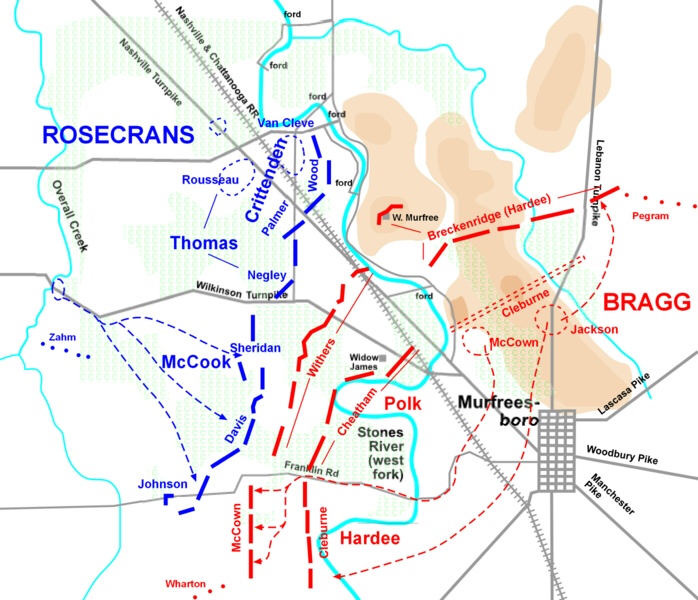
|
| (Stones River Battlefield Map) |
Union and Confederate battlefield positions on December 31, 1862, 8:00
a.m.
| Battle of Stones River Map: December 31, 1862 |
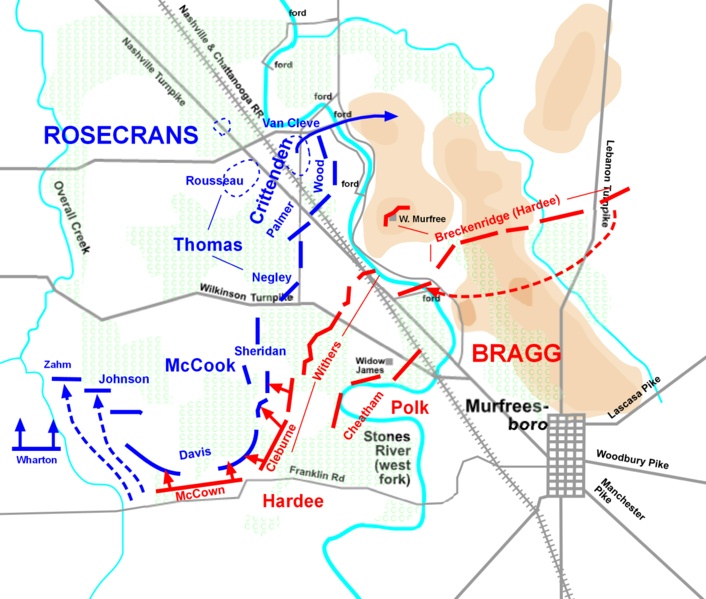
|
| (Stones River Battlefield Map) |
Union and Confederate troop positions on December 31, 1862, 9:45 a.m.
| Battle of Stones River Map: December 31, 1862 |
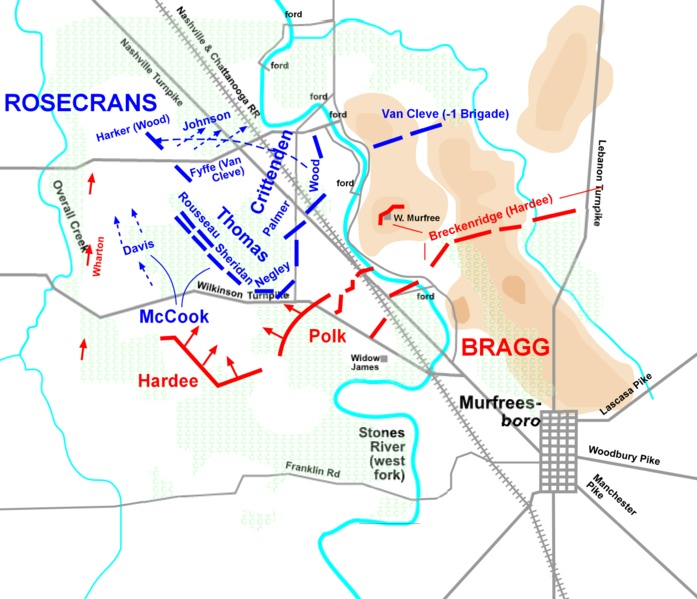
|
| (Stones River Battlefield Map) |
Union and Confederate armies at Stones River on December 31, 1862, 11:00 a.m.
| Battle of Stones River Map: December 31, 1862 |
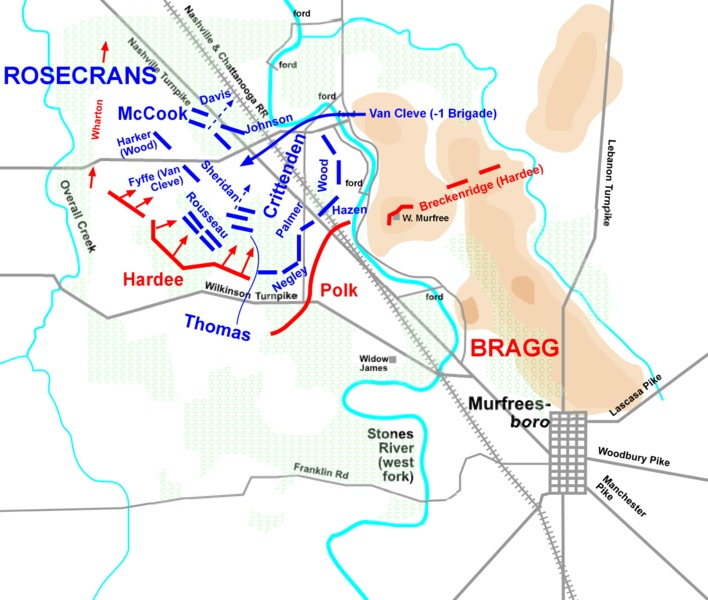
|
| (Stones River Battlefield Map) |
Union and Confederate forces at Stones River on December 31, 1862, 4:00 p.m.
| Battle of Stones River Map: December 31, 1862 |
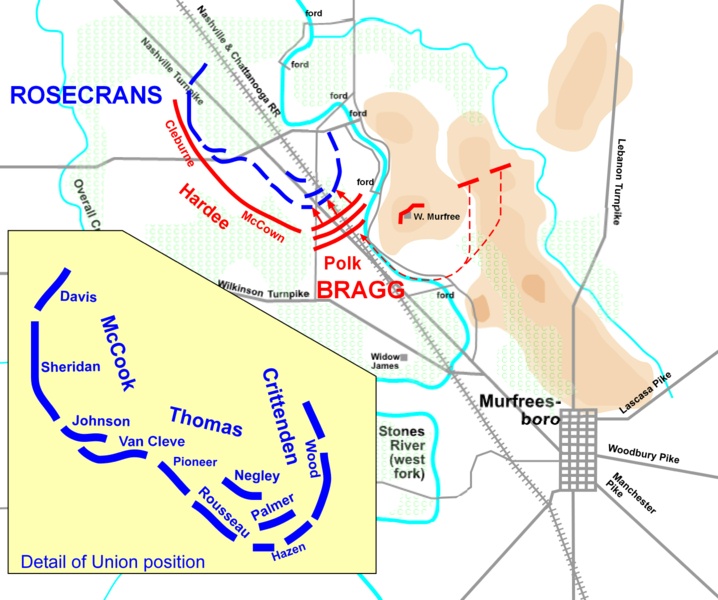
|
| (Stones River Battlefield Map) |
Union and Confederate battlefield positions on January 2, 1863, 4:00 p.m.
| Battle of Stones River Map: January 2, 1863 |
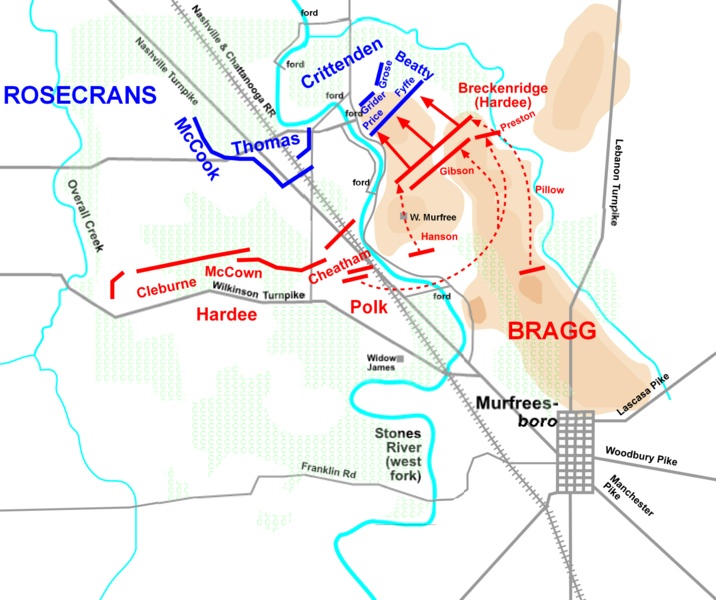
|
| (Stones River Battlefield Map) |
Union and Confederate troops at Stones River on January 2, 1863, 4:45 p.m.
| Battle of Stones River Map: January 2, 1863 |
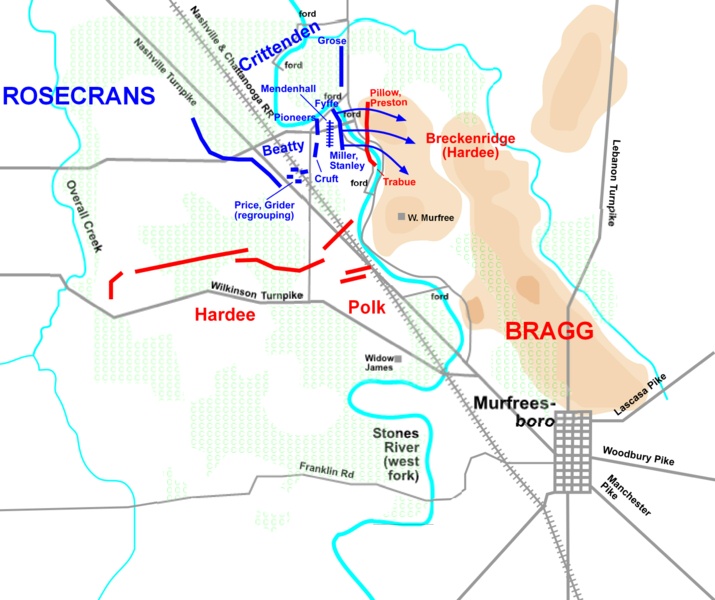
|
| (Stones River Battlefield Map) |
Recommended Reading: No Better Place to Die: THE BATTLE OF STONES
RIVER (Civil War Trilogy). Library
Journal: Until now only three book-length studies of the bloody Tennessee
battle near Stone's River existed, all old and none satisfactory by current historical standards. This important book covers
the late 1862 campaign and battle in detail. Though adjudged a tactical draw, Cozzens shows how damaging it was to the South.
Continued below.
Not only did it effectively lose Tennessee,
but it completely rent the upper command structure of the Confederacy's major western army. Valuable for its attention to
the eccentric personalities of army commanders Bragg and Rosecrans, to the overall campaign, and to tactical fine points,
the book is solidly based on extensive and broad research. Essential for period scholars but quite accessible for general
readers.
Recommended Reading: Six Armies in Tennessee:
The Chickamauga and Chattanooga
Campaigns (Great Campaigns of the Civil War). Description: When Vicksburg fell to Union forces under General
Grant in July 1863, the balance turned against the Confederacy in the trans-Appalachian theater. The Federal success along
the river opened the way for advances into central and eastern Tennessee, which culminated
in the bloody battle of Chickamauga and then a struggle for Chattanooga. Chickamauga
is usually counted as a Confederate victory, albeit a costly one. Continued below.
That battle—indeed the entire campaign—is marked by muddle and blunders occasionally relieved
by strokes of brilliant generalship and high courage. The campaign ended significant Confederate presence in Tennessee and left the Union
poised to advance upon Atlanta and the Confederacy on the
brink of defeat in the western theater.
Recommended Reading: CIVIL
WAR IN WEST SLIP CASES: From Stones River to Chattanooga
[BOX SET], by Peter Cozzens (1528 pages) (University
of Illinois Press). Description:
This trilogy very competently fills in much needed analysis and detail on the critical Civil War battles of Stones River, Chickamauga
and Chattanooga. "Cozzens
comprehensive study of these three great battles has set a new standard in Civil War studies....the research, detail and accuracy
are first-rate." Continued below.
Mr. Cozzens' has delivered a very valuable, enjoyable work deserving of attention.
The art work by Keith Rocco is also a nice touch, effecting, without sentimentality...historical art which contributes to
the whole.
Recommended Reading: The Civil
War Battlefield Guide: The Definitive Guide, Completely Revised, with New Maps and More Than 300 Additional Battles
(Second Edition) (Hardcover). Description: This new
edition of the definitive guide to Civil War battlefields is really a completely new book. While the first edition covered
60 major battlefields, from Fort Sumter to Appomattox, the second covers all of the 384
designated as the "principal battlefields" in the American Civil War Sites Advisory Commission Report. Continued
below.
As in the first edition, the essays are authoritative and concise, written by such leading Civil War
historians as James M. McPherson, Stephen W. Sears, Edwin C. Bearss, James I. Robinson, Jr., and Gary W. Gallager. The second
edition also features 83 new four-color maps covering the most important battles. The Civil War Battlefield Guide is an essential
reference for anyone interested in the Civil War.
Recommended Reading:
Shiloh and the Western Campaign of 1862. Review: The bloody and decisive two-day
battle of Shiloh (April 6-7, 1862) changed the entire course of the American Civil War. The
stunning Northern victory thrust Union commander Ulysses S. Grant into the national spotlight, claimed the life of Confederate
commander Albert S. Johnston, and forever buried the notion that the Civil War would be a short conflict. The conflagration
at Shiloh had its roots in the strong Union advance during the winter of 1861-1862 that resulted in the capture of Forts Henry
and Donelson in Tennessee. Continued below.
The offensive collapsed General
Albert S. Johnston advanced line in Kentucky and forced him to withdraw all the way to northern Mississippi.
Anxious to attack the enemy, Johnston began concentrating Southern forces at Corinth,
a major railroad center just below the Tennessee border.
His bold plan called for his Army of the Mississippi to march north and destroy General Grant's
Army of the Tennessee before it could link up with another
Union army on the way to join him. On the morning of April 6, Johnston boasted to his subordinates,
"Tonight we will water our horses in the Tennessee!" They
nearly did so. Johnston's sweeping attack hit the unsuspecting Federal camps at Pittsburg Landing
and routed the enemy from position after position as they fell back toward the Tennessee River.
Johnston's sudden death in the Peach Orchard, however, coupled
with stubborn Federal resistance, widespread confusion, and Grant's dogged determination to hold the field, saved the Union
army from destruction. The arrival of General Don C. Buell's reinforcements that night turned the tide of battle. The next
day, Grant seized the initiative and attacked the Confederates, driving them from the field. Shiloh
was one of the bloodiest battles of the entire war, with nearly 24,000 men killed, wounded, and missing. Edward Cunningham,
a young Ph.D. candidate studying under the legendary T. Harry Williams at Louisiana
State University, researched and wrote Shiloh and the Western Campaign of 1862 in 1966. Although it remained unpublished, many Shiloh
experts and park rangers consider it to be the best overall examination of the battle ever written. Indeed, Shiloh
historiography is just now catching up with Cunningham, who was decades ahead of modern scholarship. Western Civil War historians
Gary D. Joiner and Timothy B. Smith have resurrected Cunningham's beautifully written and deeply researched manuscript from
its undeserved obscurity. Fully edited and richly annotated with updated citations and observations, original maps, and a
complete order of battle and table of losses, Shiloh and the Western Campaign of 1862 will
be welcomed by everyone who enjoys battle history at its finest. Edward Cunningham, Ph.D., studied under T. Harry Williams
at Louisiana State
University. He was the author of The Port Hudson Campaign: 1862-1863
(LSU, 1963). Dr. Cunningham died in 1997. Gary D. Joiner, Ph.D. is the author of One Damn Blunder from Beginning to End: The
Red River Campaign of 1864, winner of the 2004 Albert Castel Award and the 2005 A. M. Pate, Jr., Award, and Through the Howling
Wilderness: The 1864 Red River Campaign and Union Failure in the West. He lives in Shreveport,
Louisiana. About the Author: Timothy B. Smith, Ph.D., is author of Champion Hill:
Decisive Battle for Vicksburg (winner of the 2004 Mississippi
Institute of Arts and Letters Non-fiction Award), The Untold Story of Shiloh: The Battle and the Battlefield, and This Great
Battlefield of Shiloh: History, Memory, and the Establishment of a Civil War National Military Park. A former ranger at Shiloh,
Tim teaches history at the University of Tennessee.
|

